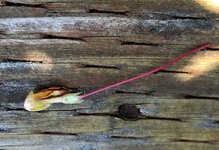The first question I ask myself before chopping, is what’s my plan for this tree, and azaleas in particular as I’ve got lots of them that started off in the shape yours is in.
imo for azaleas specifically, Its better to see if there is anything left in the present structure of the tree already to give you a “line” and leave this intact. You can wire it to be how you like. Then before you cut, look for 1-2 complementary side branches to leave also. These branches may be temporary, or not, yet by doing so you save about a year of growing out and cutting back as there is a response in the azalea putting out buds when you keep the sap flowing through the trunk. It will also force you to plan the base primary structure right off, which gives you a clear goal for the tree Finally be absolutely sure to leave vegetation on the end of each branch.
In the past two years I’ve done a number of experiments with 2-5 year old azaleas this has shown to be the case each time time. Here’s a couple examples of 2 - 4 year olds.
.
View attachment 387013 View attachment 387014 View attachment 387015 View attachment 387016
Flowers - just as
@Shibui mentions, energy savings comes from removing the ovaries which become the seed pod, as opposed to just removing flowers. Thus includes removing as much of the calyx as possible… shown in these images.
View attachment 387020 View attachment 387022 View attachment 387021
Fertilization - In the PacNW fertilization goes from late Feb -the end of Sept, with a halt the month of blooming. Some azaleas are prone to winter bark split if fertilized later the Sept. I use slow release Osmocote Plus with 1.5 - 2 weekly Miracle Gro & Humic acid for those in kanuma. Use less frequent fertilization for plants still in the peat/perlite nursery mix to avoid fertilizer burn.
If you do a severe cut back as shown above, it’s best to remove the flower buds in the late winter here when growing out azalea until the next year, except maybe a couple. Why…. Flower buds temporarily halt the extended growth of azalea stems.…. and then push out multiple extensions, splattering growth in all directions. Here’s an example of a whip left to bud on purpose as an experiment. You can see the kink on the stem? That’s where it budded. Then it sent out five new stems at the base of the bud, all but one were removed and the one left if is now the trunk. The upshot of this is that all vertical growth was temporarily stopped, then the energy was spread amongst all the new stems. For me it’s better to keep the energy going to growth.
View attachment 387023
cheers
DSD sends











